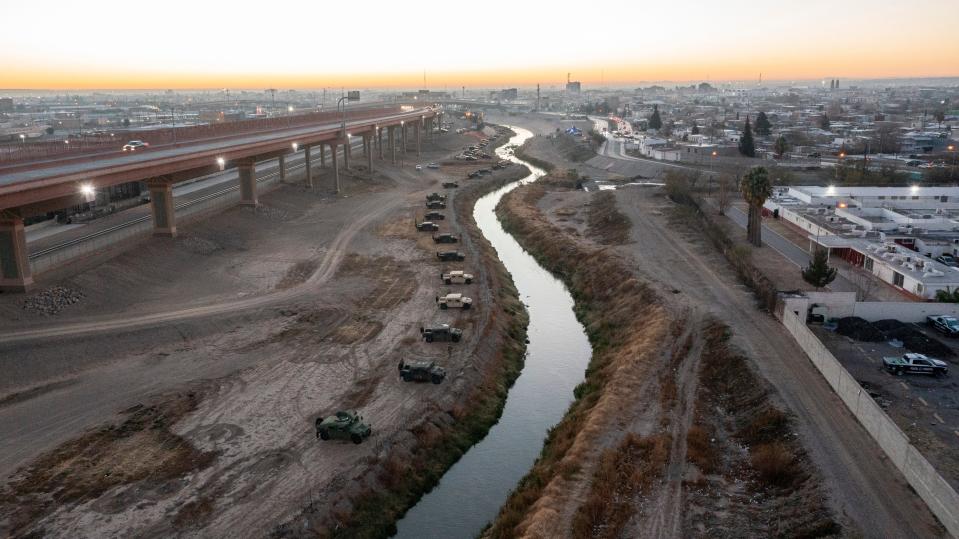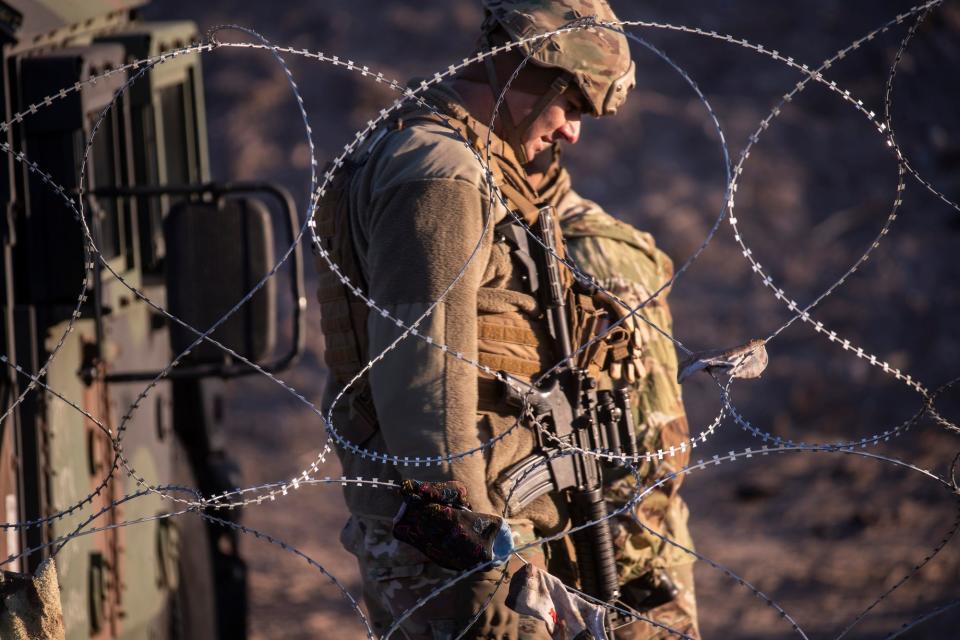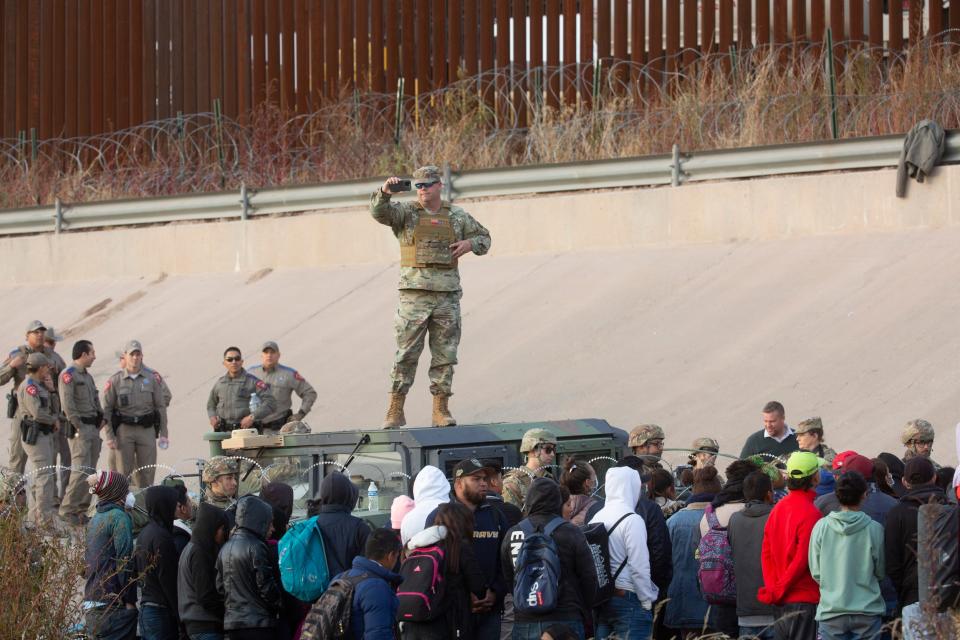El Pasoans troubled by National Guard tactics, fate of Title 42 caught in litigation
- Oops!Something went wrong.Please try again later.
Editor's note: This story has been updated to reflect that during the Mexican Revolution, 110,000 National Guard soldiers were stationed along the U.S.-Mexico border, not just in El Paso.
EL PASO — Under the cover of night, armed Texas National Guard soldiers strung a razor-wire barricade at the edge of the Rio Grande — a scene that evoked a war zone and troubled many in a community that often recalls its immigrant roots with pride.
When El Paso Mayor Oscar Leeser declared an emergency over the weekend, it was a cry for help to the state of Texas for beds, buses, public safety and shelter support for the hundreds of migrants being legally released by Border Patrol each day.
Gov. Greg Abbott responded by sending soldiers to the El Paso border. They stationed Humvees, staged reams of concertina wire and gripped their rifles in the face of men, women and children seeking asylum.

The governor said Wednesday it is part of a "blockade" that will be extended along the El Paso border.
"Unfortunately, it represents the arrival of Operation Lone Star to the border in El Paso," said Fernando Garcia, executive director of the Border Network for Human Rights. "El Paso is one of the most welcoming cities in Texas. This is an attack on what El Paso represents."
The governor has supplied state troopers to support El Paso police in public safety and charter buses to boost the city's transportation capacity, Leeser said. The National Guard deployment is "an exercise in training and preparation" and wasn't part of the city's request for assistance.
"They're not optics that we like," Leeser told CNN on Wednesday. "One thing about El Paso: We're a very caring community."
Although the U.S.-Mexico border is often used as a backdrop for political posturing by elected officials, including the Texas governor, El Paso had largely managed to avoid large-scale military interventions by Abbott's administration until this week.
Yet militarization in the Borderland is nothing new, said David Dorado Romo, an El Paso historian specializing in border history.

El Paso has at least a century of experience with military mobilizations, dating to the Mexican Revolution. At the time, the U.S. had stationed 110,000 U.S. National Guard soldiers along the border, including in El Paso, he said. The U.S. government was also using public health measures to stop migration from Mexico.
"You would see images of people crossing the border in huge lines, just like today," he said. "Thousands of them were housed in makeshift tents at Fort Bliss; they were interned. There was a lot of anti-brown rhetoric of people south of the border. There are so many parallels."
Border residents are used to hearing the chop of U.S. Customs and Border Protection helicopters circling overhead and seeing green-and-white Border Patrol SUVs in their neighborhoods. Every day, thousands of fronterizos crisscross international bridges topped with piles of razor wire and concrete barricades placed there during the Trump administration.
More:What is Title 42, when does it end, how does it impact US-Mexico border? Here's what to know
But the sight of heavily armed soldiers and military vehicles at the river's edge was triggering for some El Pasoans.
The governor has often equated the arrival of asylum seekers to an "invasion" — the sort of language that motivated a racist mass attack in El Paso in 2019 that left 23 people dead and dozens injured in a mass shooting massacre.
The National Guard deployment at the border "is a really negative symbol of our relationship and a frightening one for a lot of people on a very basic level," said Bishop Mark Seitz of the Diocese of El Paso. "It’s reflective of a mistaken notion of what is happening here: We are not facing an invading army. We are facing people who have fled here seeking refuge."

In a news conference in Austin on Wednesday, Abbott said the installation of razor wire near the border fence in El Paso "was really Day One of what's going to be a multi-day, multi-series of actions taken by the National Guard where they were putting up more elements of what will constitute a blockade."
The governor has asked the Biden administration to send more federal resources to border communities.
Asylum seekers have been arriving at the El Paso border in large numbers for months. The pace of arrivals surged in recent days as the Biden administration prepared to end its use of Title 42 to quickly expel some migrants at the border.
The fate of Title 42 is caught in litigation that reached the U.S. Supreme Court this week.
With the aid from the Biden administration and American Red Cross, the city and county continued to ramp up the humanitarian response to increased migration by opening the convention center and two vacant schools as shelters for asylum seekers and other migrants, Leeser said.
Once Title 42 ends — on a to-be-determined date — the city could see as many as 4,000 to 6,000 asylum seekers daily, up from a recent peak average of around 2,500 daily, he said.
"We are working with all our partners within the community to make sure we have the right resources," Leeser said. "We're preparing for the unknown."
El Paso residents have showed up spontaneously day and night Downtown to deliver hot coffee and food to migrants stuck on the street, donate blankets and jackets or bring toys to the children.
U.S. Rep. Veronica Escobar, D-El Paso, said the governor's "show of force" at the border was a "misuse of resources."
Border Patrol agents were asking soldiers to move the razor wire to allow them to process asylum seekers, who have been waiting patiently in line on the north bank of the Rio Grande, she said.
"The vast majority of El Pasoans have responded with charity and goodwill," she said, "by making food and taking it to the migrants, or dropping off clothing and coffee. These are our better angels who are responding with love."
John Moritz contributed to this report.
This article originally appeared on El Paso Times: El Paso troubled by Texas National Guard tactics amid migrant crisis

